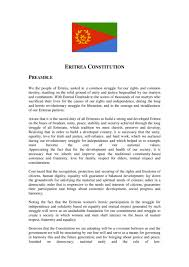This week we are still in Africa, and this is a country I only
recently heard of while watching something on YouTube about modern day slavery.
So, we are looking at the country of Eritrea.
Eritrea is a northeast African country on the Red Sea coast. It
shares borders with Ethiopia, Sudan and Djibouti. The capital city, Asmara, is
known for its Italian colonial buildings, like St. Joseph's Cathedral, as well
as art deco structures. Italian, Egyptian and Turkish architecture in Massawa
reflect the port city's colourful history. Notable buildings here include St.
Mariam Cathedral and the Imperial Palace.
It has a population of 3.7 million and has no official language,
as it is a multilingual country, and as the
Constitution establishes the "equality of all Eritrean languages".
Tigrinya, Arabic, and English serve as de facto working languages, with
English used in university education and many technical fields.
The flag of Eritrea is made up of a red triangle, a green triangle, and a blue triangle, with a yellow olive branch and wreath in the centre. The first Eritrean flag was adopted in 1952, but was replaced by Ethiopia in 1958, The Eritrean People's Liberation Front (EPLF) adopted a flag in 1977, the current flag was adopted on December 5, 1995.
The country’s official religions are Eritrean Orthodox
Tewahedo Christianity, Sunni Islam, Roman Catholicism, and Evangelical
Protestantism. However, the government restricts the activities of these
religions and persecutes members of unregistered religious groups.
What does this mean? Well, the government's constitution and
laws prohibit discrimination based on religion. However, the government
restricts the activities of the officially recognized religions. The
government intimidates and prosecutes people who practice unregistered
religions, it also prevents unregistered religions from building houses of
worship or practicing their religion. Also, the government detains people
for their religious beliefs, including minors.
The currency is the nakfa and
was introduced on 15 November 1997 to replace the Ethiopian birr at par. It
takes it name from then place of Nakfa were the first victory in their war of independence
took place.
Like many other African countries,
it is not a safe place to visit.
The country’s education system includes basic, secondary, and
tertiary education. The government has been working to improve the quality
of education and increase access to schools. Due to the country’s geography
which include remote areas education is difficult.
Other problems are the amount of poverty, and many children
living in nomadic areas also children with disabilities have difficulty
accessing education.
In fact, many children are unable to read and understand what
they are reading, and it is not unusual for as much as 48% of primary
school-aged children to not attend school.
Eritrea has been involved in several wars and conflicts,
including the Eritrean–Ethiopian War, the Djiboutian–Eritrean conflict, and the
Tigray War.
Eritrean–Ethiopian War lasted from 1998 to 2000 and was between
Eritrea and Ethiopia. The war resulted in the Algiers Agreement, tens of
thousands lost their lives on both sides. The war resulted in minor changes to
the border between the two countries.
Eritrean–Ethiopian border conflict this was a violent
standoff and proxy conflict between Eritrea and Ethiopia that lasted from 1998
to 2018. In 2018, Ethiopia agreed to cede Badme to Eritrea.
Eritrean War of Independence as armed conflict that lasted from
1961 to 1991 this war ended in 1991 with the fall of the Derg regime.
Djiboutian–Eritrean conflict occurred in 2008 between
Eritrea and Djibouti it lasted only three days of indecisive fighting.
Lastly there was the Tigray War a conflict that occurred
from 2020 to 2022 between Ethiopia and Eritrea it ended with the
Ethiopia–Tigray peace agreement.













I've never heard of that place but I found your post to be very interesting, Jo-Anne.
ReplyDeleteIt is new to me as well, I am pleased you found it interesting
DeleteIt prohibits religious discrimination, yet discriminates against religions not "registered". I've never heard of this country either!!
ReplyDeleteYeah that sounds weird and I don't think many would have heard of it
DeleteNever heard of this country. Persecuting people for their religions and soldiers about...not a good place to visit, for sure. Very sad to hear.
ReplyDeleteThat's for sure, not a place I would want to visit
DeleteVery good job of educating us here!
ReplyDeleteI am pleased you found it educating as I feel it's good to learn about other countries and such
Delete